SYNOPSIS
!
SPOILER ALERT !
The central
focus and namegiving object of this six
issues story arc are the fragments of the
powerful Bloodstone, needed by Baron
Helmut Zemo in order to fulfill his
obsession and raise his father, Heinrich,
from the dead. The ensuing hunt takes
Captain America and his female side-kick
Diamondback all over the world in order
to stop Zemo and his mercenaries Batroc,
Zaran and Machete - not to mention fights
with cannibals, sharks, snakes, mummies
and the undead...
In Captain
America #360, halfway into the
story, Cap battles Zaran and Machete in
the shark-infested waters off Bermuda for
the last fragment of the Bloodstone. When
the sea predators attack, the two
villains escape, leaving Cap to battle it
out.
Meanwhile,
Diamondback has located Baron Zemo’s
yacht and, after a prolongued struggle
with his psychic henchman Tristram
Macawber, seizes the boat and greets the
returning Batroc with the case containing
the first two Bloodstone fragments - plus
Zemo as a hostage. Trickery is thrown
into the confrontation, and ultimately
Diamondback retreats with her two pieces
of the Bloodstone while Batroc remains in
possession of the one found at the bottom
of the sea.
|
|
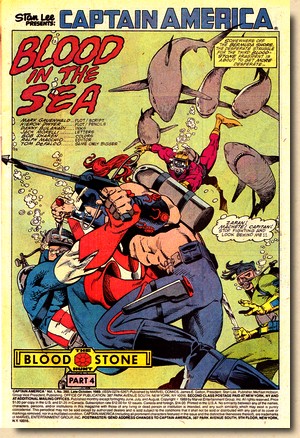 |
|
|
| |
| Cap resurfaces and rescues
the wounded Diamond, and while he signals for them to be
picked up a mysterious figure with a skull mask and
crossbones on his chest watches from a nearby boat. |
| |

|
|
Once
airborn, SHIELD's "bloodstone
detector" sends them to Egypt, where
Cap and Diamond discover an entrance to
an underground crypt near the famous
Gizeh Pyramids. As they explore the
ancient tomb, the floor suddenly drops
out from beneath them and opens up to a
pit of poisonous snakes…. to be
continued
|
|
|
| |
| |
SECOND
FEATURE
U.S.
Agent
"Conflagration: The Night of the
Scourge!" (part 3 of 5)
! SPOILER
ALERT !
Beneath the
mansion of power broker Curtiss Jackson,
U.S. Agent is fighting a vigilante called
Scourge of the Underworld who is on a
mission to kill Jackson (hiding in his
private lab where he hopes to be safe
from the assassin). Things are not going
well for U.S. Agent as Scourge brings
half the building down, leaving U.S.
Agent buried underneath the rubble and
Scourge heading for Jackson's lab.... to
be continued
|
|
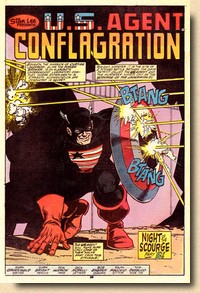 |
|
|
| |
| |
REVIEW & ANALYSIS
Captain America
#360 was published in late 1989, right at the end of an
era which was still connected in many ways to the classic
Silver and Bronze Age. Only a few months later, the 1990s
would roll around - and Marvel (and large parts of the
comic book scene along with them) would go increasingly
bonkers, publishing what felt like a million (mostly
awful) X-Men titles and half a million (definitely awful)
Spider-Man titles and not much else, in a painfully
endless stream of clones and mutants all sandwiched
between chromium covers.
|
| |
| Mark
Gruenwald (who started working for Marvel
as an assistant editor in 1978 and stayed
with the company for his entire career)
was at the writer's helm for Captain
America from 1985 to 1995, and during
this run he always packed a huge punch of
wild ideas and big thrill adventures into
his stories, giving readers a rendition
of Captain America who fought a varied
and colourful gallery of costumed rogues
while saving the world from peril.
Gruenwald's Cap stories were as good as
any of the best and would go on to become
part of the "classic Cap" canon
themselves. In 1996, aged only
43, Gruenwald suffered a fatal heart
attack; famously, his live long love for
comic books resulted in his ashes, as per
his wish, being mixed with the ink used
to print the first printing of the TPB
compilation of Squadron Supreme.
"The
Bloodstone Hunt", of which Captain
America #360 was part 4 of 6, feels
very much like the Indiana Jones movie
also released in 1989, a swashbuckling
tale of adventure and espionage which at
the heart of its plot is like a treasure
hunt across the world for a prized,
almost mythical object.
|
|
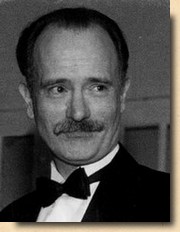 |
|
|
| |
| Gruenwald does it with
bravado, producing an exciting storyline which never
loses its pace. The story arc also introduces Crossbones,
a villain which would come to play a central part in Ed
Brubaker's Captain America saga in the 2000s. |
| |
 |
|
A
large part of the accolades given to the
"Bloodstone Hunt" goes to
Kieron Dwyer (*1967), who co-plotted,
drew and inked it. Following his first
published work in Batman #413 in
November 1987, Dwyer worked for both
Marvel (including pencils on Captain
America from 1987 to 1990) and DC,
and his work generally seems to be
somewhat underrated. His clear pencilling
style, enhanced by his light inking,
provides visuals which are full of detail
and have a captivating way of working the
plot and pushing the story onwards.
In the case
of the "Bloodstone Hunt"
Dwyer's artwork provides the
cinematographic style which makes this
Captain America story work so well, as
exemplified by his rendition of the
exotic locations in Egypt where some of
the action takes place in front of the
pyramids and inside underground tombs.
|
|
|
| |
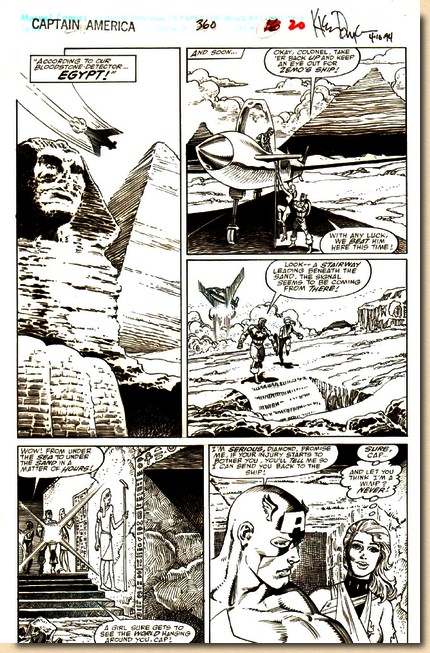 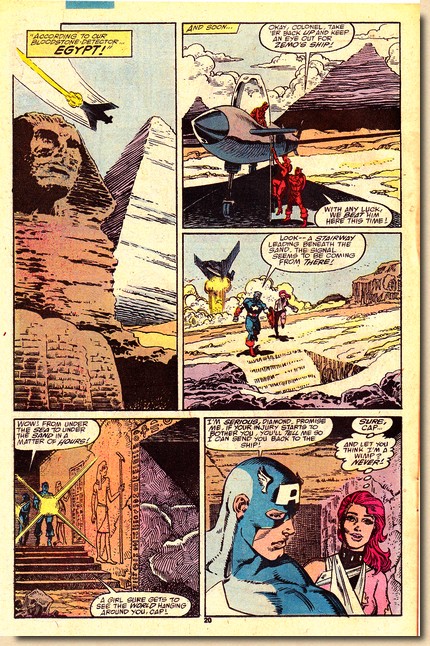
Original
artwork by Kieron Dwyer (pencils & inks) for page 20
of Captain America #360 (scanned from the original)
and the same page as it appeared in print
|
| |
| |
FACTS & TRIVIA
|
| |
| The Bullpen
Bulletin was one of those
elements which for the longest
time made a Marvel comic book a
marvel comic book. It was still
around in 1989, as was Stan Lee's
famous soapbox (although this had
been done away with in the early
1980s and only returned in late
1986). Interestingly
enough from today's perspective
and enhanced with hindsight, Stan
Lee is going on about nothing
else other than various movie
projects. The ones mentioned
either failed to materialize or
weren't a big success, but the
box office hits would come, and
it does seem like Stan "the
Man" always saw and believed
in the silver screen potential of
the characters he co-created back
in the 1960s.
The Bullpen
Bulletins proper dealt
exclusively with various comic
conventions, a sign that fandom
was expanding, including its
comercialization.
A feature
actually introduced by Mark
Gruenwald (who took over the
editorial reins of the bullpen
bulletins in 1987) was the pro
file, a short Marvel
Handbook-style profiles of
Marvel staff-members. In this
issue, readers got to learn more
about Renée Witterstaetter, who
started her career as an
assistant editor at DC Comics
working on the Superman
comics and later worked at Marvel
Comics on Silver Surfer
and Conan; wWhile at
Marvel she was a colorist on many
series including the Avengers,
Spider-Man and Captain
America.
|
|
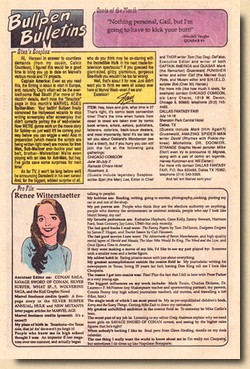
Bullpen
Bulletin
|
|
|
|
| |

Letters page
(click to view entire page)
|
|
The Bullpen Bulletin
is complemented by a letters page
(somewhat awkwardly named "American
Graffiti" at the time); the only
other in-house content is a subscriptions
page which features an interesting
variety of titles available along with a
rather lacklustre illustrattion of
Wolverine's claws. A subscription for
regular Marvel titles in 1989, by the
way, would put you back $9.75 a year
(i.e. 75¢ instead of $1.00 an issue). |
|
|
| |
| The (in)famous "flea
market adverts" were gone by 1989, replaced by comic
convention organisers, comic book sellers and a few
non-comics products. |
| |
|
| |
| Of
these, the Nintendo ad has an interesting
"writing on the wall" type of flavour
when viewed today, but back in 1989, Advanced
Dungeons & Dragons still held sway over pixel
graphics video console games.
The "Bloodstone
Hunt" has been reprinted more than once by
Marvel, which can safely be taken as an
indication of its quality and appeal; first in
1993 as Captain America: The Bloodstone Hunt,
then in 2011 in a trade paperback titled Captain
America: Scourge of the Underworld, and then
in 2018 in the Marvel Epic series as Captain
America: The Bloodstone Hunt, for which the
solicitation reads as follows:
|
|
 |
|
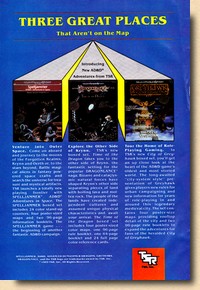 |
|
| |
"Steve
Rogers is back in the red, white and
blue! With his familiar shield in
hand, Steve battles alongside Nick
Fury and takes on the Supreme
Soviets! But his return to the mantle
of Cap may come to a swift end as he
struggles to survive Mother Night's
camp of hate — while transformed
into a scrawny teenager! And the
erstwhile Cap, John Walker, makes his
return as the take-no-prisoners
U.S.Agent! Then, a classic caper
begins as Baron Zemo targets the
powerful Bloodstone — and Cap
joins the hunt along with
Diamondback! She's a foe turned
friend, but could she be more? Before
the saga is over, they'll face
Batroc's Brigade, cannibals, sharks,
snakes and even mummies! Plus:
Crossbones targets Diamondback,
Sub-Mariner goes wild and Magneto
nearly kills the Red Skull!"
In 1988
German publisher Condor launched Captain
America Taschenbuch, a digest size
collection of Cap stories from the 1980s
which was available three times a year
and lasted for a total of 26 issues,
until cancelled in 1996.
Captain
America Taschenbuch #11 reprinted
the first four issues of the Bloodstone
Hunt in 1991 and concluded the run in
issue #12.
|
|
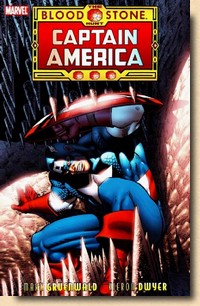 |
|
|
| |
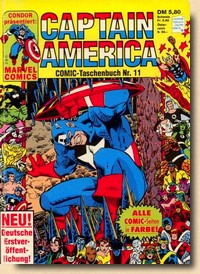 |
|
The
illustrations presented here are
copyright material.
Their reproduction for the review and
research purposes of this website is
considered fair use
as set out by the Copyright Act of 1976,
17 U.S.C. par. 107.

(c) 2018
uploaded
to the web 30 September 2018
|
|
|
| |
|